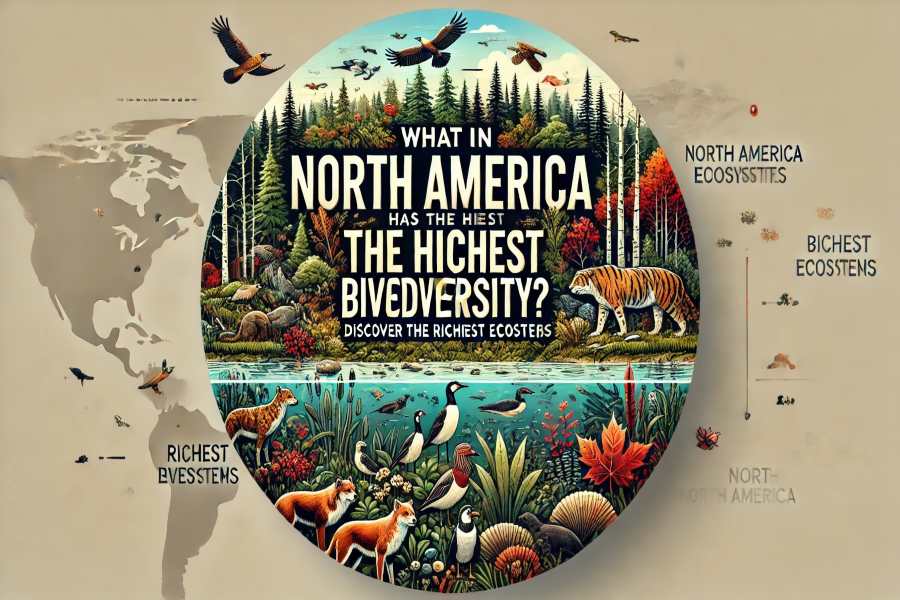Biodiversity is a crucial indicator of the health and resilience of ecosystems. In North America, various biomes exhibit unique characteristics and species diversity. Among these, one biome stands out for its remarkable biodiversity. Understanding which biome in North America has the highest biodiversity involves exploring the intricate web of life that thrives within it. This article delves into the rich and varied world of this biome, highlighting the factors that contribute to its high biodiversity, the species it supports, and the ecological importance of preserving such a vibrant ecosystem.
In this article, we will explore the biome that claims the title of the highest biodiversity in North America. We will examine its unique features, the species that call it home, and the ongoing efforts to protect and sustain its rich biodiversity. Whether you are a nature enthusiast, a student, or a conservationist, understanding the importance of this biome and the challenges it faces is crucial for fostering a deeper appreciation and commitment to preserving our natural world.
What Biome In North America Has The Highest Biodiversity?
The biome in North America with the highest biodiversity is the temperate rainforest. This biome, characterized by its lush vegetation and abundant rainfall, supports a wide variety of plant and animal species, making it one of the most diverse ecosystems on the continent.
The Temperate Rainforest: North America’s Biodiversity Hotspot
The temperate rainforest is renowned for its unparalleled biodiversity in North America. This biome stretches along the Pacific Coast, from northern California through Oregon, Washington, and into Canada and Alaska. The temperate rainforest thrives in this region due to the consistent, heavy rainfall and mild temperatures, creating an ideal environment for a vast array of species.
One of the most striking features of the temperate rainforest is its dense canopy of towering conifers, including Douglas fir, Sitka spruce, and western hemlock. These trees, some of which are centuries old, provide critical habitats for numerous bird species, mammals, and insects. The understory is equally lush, with ferns, mosses, and shrubs creating a multi-layered ecosystem teeming with life.
The temperate rainforest is home to a variety of mammals, including black bears, cougars, and Roosevelt elk. The rich plant life supports diverse herbivores, which in turn sustain a range of predators. Birdwatchers flock to this biome to observe species such as the northern spotted owl, marbled murrelet, and various woodpeckers.
Salmon play a pivotal role in the temperate rainforest’s ecosystem. These fish, which migrate from the ocean to spawn in freshwater streams, are a crucial food source for many animals, including bears and eagles. The nutrients from decaying salmon carcasses also enrich the soil, supporting plant growth and further enhancing biodiversity.
Efforts to preserve the temperate rainforest are vital. Logging, urban development, and climate change pose significant threats to this biome. Conservation initiatives focus on protecting old-growth forests, restoring damaged ecosystems, and mitigating human impact to ensure the temperate rainforest remains a biodiversity haven.
Unique Features Of The Temperate Rainforest
1. Climate and Geography
The temperate rainforest’s climate is characterized by heavy rainfall and mild temperatures. This consistent moisture supports lush vegetation year-round, creating an ideal habitat for diverse species.
2. Flora Diversity
The plant life in the temperate rainforest is extraordinarily varied. From towering conifers to a rich understory of ferns and shrubs, this biome supports a complex web of plant species that provide food and shelter for numerous animals.
3. Fauna Diversity
The temperate rainforest is home to a wide range of animals, including large mammals like black bears and cougars, smaller mammals like raccoons and squirrels, and an impressive array of bird species. This diversity of fauna is a testament to the biome’s rich ecosystem.
4. Ecological Interactions
The interactions between species in the temperate rainforest are complex and vital to the ecosystem’s health. Predators, herbivores, and plants are all interconnected in a web of life that sustains the biome’s biodiversity.
5. Conservation Efforts
Preserving the temperate rainforest is essential for maintaining its biodiversity. Efforts include protecting old-growth forests, promoting sustainable logging practices, and addressing climate change impacts.
Importance Of The Temperate Rainforest
The temperate rainforest, with its lush vegetation and abundant rainfall, plays a crucial role in maintaining ecological balance and supporting a wide variety of species. Here are several key reasons why the temperate rainforest is vital:
- High Biodiversity: The temperate rainforest is renowned for its extraordinary biodiversity. It supports a rich array of plant and animal species, many of which are endemic and cannot be found elsewhere. This diversity is not only fascinating but also essential for the resilience and adaptability of ecosystems.
- Critical Habitats: The dense canopy and varied understory of the temperate rainforest provide critical habitats for numerous species. Old-growth trees offer nesting sites for birds like the northern spotted owl, while the forest floor shelters small mammals and insects. The interconnectedness of these habitats ensures the survival of diverse life forms.
- Carbon Sequestration: Temperate rainforests play a significant role in carbon sequestration, helping to mitigate the effects of climate change. The large trees in these forests absorb and store vast amounts of carbon dioxide, which helps reduce greenhouse gas levels in the atmosphere.
- Recreational Opportunities: Temperate rainforests offer abundant recreational opportunities for humans. From hiking and birdwatching to photography and nature study, these forests provide a natural escape and a chance to connect with the environment. The economic benefits from ecotourism also support local communities.
- Ecological Research: The complexity and richness of the temperate rainforest make it a valuable area for ecological research. Scientists study its unique ecosystems to understand better the interactions between species, the effects of climate change, and the best practices for conservation. This research is crucial for informing global conservation strategies.
- Water Regulation: The temperate rainforest plays a vital role in regulating water cycles. The dense vegetation and soil absorb and slowly release water, maintaining stream flow and reducing the risk of floods. This natural regulation is essential for the health of aquatic ecosystems and human water supply.
The Temperate Rainforest: A Model For Conservation
The temperate rainforest stands as a model for conservation efforts worldwide. Its high biodiversity and complex ecosystems make it a critical area for study and preservation. Understanding the unique features and challenges of the temperate rainforest can inform broader conservation strategies.
One of the key aspects of the temperate rainforest’s conservation is the protection of old-growth forests. These ancient trees are not only significant carbon sinks but also provide habitats for species that cannot thrive elsewhere. The preservation of these forests is crucial for maintaining biodiversity.
Climate change poses a significant threat to the temperate rainforest. Rising temperatures and changing precipitation patterns can disrupt the delicate balance of this ecosystem. Conservation efforts must focus on mitigating these impacts through sustainable practices and global climate action.
Challenges And Solutions In Conserving The Temperate Rainforest
Logging and Habitat Destruction: Logging practices have historically threatened the temperate rainforest. Sustainable logging and stricter regulations are essential to protect this biome.
Urban Development: Encroachment of urban areas leads to habitat fragmentation. Urban planning and green corridors can help mitigate these impacts.
Climate Change: Climate change affects rainfall patterns and temperatures. Conservation strategies must include climate adaptation measures.
Invasive Species: Non-native species can disrupt the ecosystem. Active management and prevention strategies are necessary to control invasive species.
Community Involvement: Engaging local communities in conservation efforts ensures sustainable practices and increases awareness about the importance of the temperate rainforest.
Conclusion
The temperate rainforest, with its remarkable biodiversity, is a vital part of North America’s natural heritage. Efforts to conserve this biome are crucial for maintaining its ecological health and the services it provides. Through sustainable practices, climate action, and community involvement, we can ensure the temperate rainforest continues to thrive.
FAQs
1. What Animals Live In The Temperate Rainforest?
The temperate rainforest is home to a variety of animals, including black bears, cougars, Roosevelt elk, northern spotted owls, and numerous salmon species.
2. Why Is The Temperate Rainforest Important?
The temperate rainforest is important because it supports high biodiversity, provides critical habitats, sequesters carbon, and offers recreational and research opportunities.
3. What Threats Does The Temperate Rainforest Face?
The temperate rainforest faces threats from logging, urban development, climate change, and invasive species.
4. How Can We Help Preserve The Temperate Rainforest?
We can help preserve the temperate rainforest by supporting conservation initiatives, promoting sustainable practices, reducing our carbon footprint, and engaging in community conservation efforts.
5. Where Is The Temperate Rainforest Located?
The temperate rainforest is located along the Pacific Coast of North America, stretching from northern California through Oregon, Washington, and into Canada and Alaska.











Leave a Reply